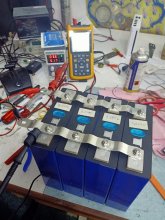I am a newbie on this, who has used a similar power supply on 24V 8 x 280Ah LiFePO4 cell set to a top balance (only) twice now. I wonder what your parallel battery voltage is now, when the Bench supply is OFF ? For me, it took personal hands on lessons to better understand my power supply. I am still a newbie, plus have never seen to total good read on using the bench power supply. What I think I learned after 1st watching Will P's video lesson on this, and from comparing notes in other threads, with my hands on: I could get to the 10 Amps (max of my particular Bench Power Supply) by dialing the voltage adjustment upwards a little bit (like to 3.8V) / and messing with the Current adjustment knob too, to get the red CC light next to current reading light up indicating Constant Current. Seem like I went for AND turning the voltage back down to 3.65V or 3.6V top / to get the green lite next to the voltage numbers would lite up indicating CV Constant Voltage, or I might have had to turn the current knob downward to get the green CV lite ON. ... The Lesson I took in from Will was I could dial up the voltage a bit at the beginning of a Top Balance to get the 10 amp max, BUT ... (I registered this later from forum study and my hands on lessons): I Learned/ & now Believe: Pay attention when voltage of battery set gets near to 3.6V ... Because once it gets to 3.4V, 3.5 V happens much more quickly, and 3.6 can be reached very quickly. So My Take is ... if you are on 3.4V (I would test w Bench Power OFF) ... adjust the voltage knob to get a green CV light next to the top up voltage you are aiming at ... 3.6V Seems like the current knob can be a factor too... When Battery Voltage is BELOW 3.4 V / maybe up voltage adjustment on Bench Power Supply in small as possible increment to get the CC Current up to 10Amps (with CC red light ON next to current reading) , and come back and see what going on hourly or maybe more. If it were my battery set, I would make sure my CV was set at 3.65V with that green lite on next to the Voltage setting on any battery set that was at 3.4V or above; and expect current to reduce way low as battery top balance reaches 3.6V or 3.65V. I am rambling as a newbie, and just giving my opinion here.
... My one other related learning curve lesson I could mention on one very long slow charge cycle on just ONE 3.2V 280Ah LiFePO4 cell: I could never get that one cell above 3.36V ...And that was because that particular one cell was one that proved to be faulty ... (it had less Ahs than it rating, and more internal resistance than my other good cells, depending on much current was flowing in or out). I was trying to getting it fully charged for a follow up Ah test. ... That is another story which I documented elsewhere in this forum / and got that one cell replaced by Xuba for being a below par cell/ for I believe was an unusual problem. Hope to hear you got up to 3.6 V on your Top Balancing session soon.




